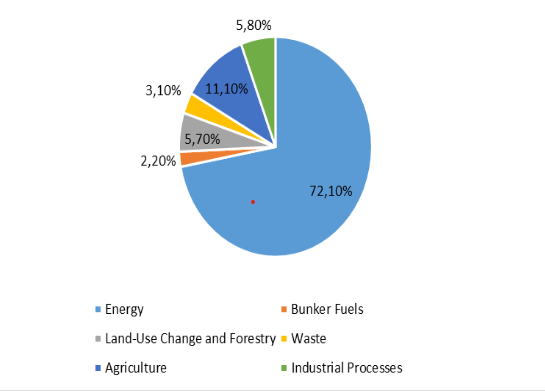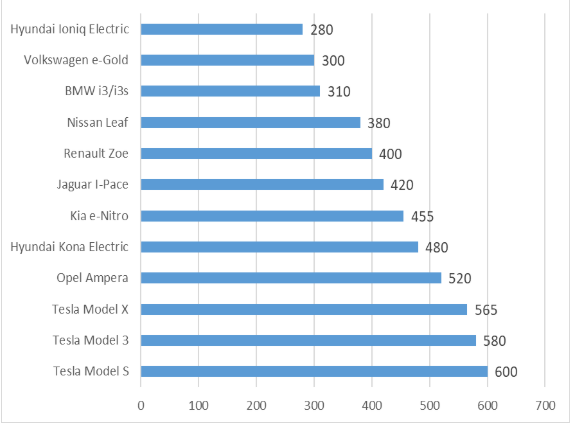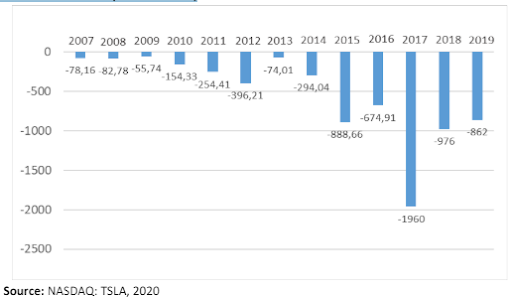Related Questions
Sustainable and Clean Energy: The Case of Tesla Company, JEFMS Journal, UK
| Subject | Sustainable and Clean Energy |
ABSTRACT:
Tesla is considered the leading electric vehicle manufacturing company in the market. It was the first company to recognize the need for a more sustainable vehicle than traditional gasoline-powered vehicles and offer its solution to the market. The company has combined the generation of electrical energy through solar cells and other SolarCity products with its vehicles, giving it a competitive advantage that none of its competitors have. Tesla’s cars are the result of continued investment in research and development and a forward-thinking approach. The company has made such an impact with its innovations that it has also changed the paths of its competitors and the industry as a whole. Within the green economy movement, Tesla has definitely been one of the pioneers influencing companies in other industries and inspiring them to take a greener and more sustainable approach.
Buy Answer of This Assessment & Raise Your Grades
I. INTRODUCTION
The global economy is undergoing a transformation due to shifts in collective consumers’ views of the products they exchange and consume and their impact on the environment have changed. This change has hit different markets that now have to adapt.
In the automotive industry, the main problem in terms of sustainability is the use of fossil fuels, which cause harmful emissions to the environment, nature and humans alike.
The solution to this problem is electric cars, but for a long time they were considered to be of lower quality and performance than gasoline-powered vehicles. Drivers have therefore been reluctant to buy them because of the many difficulties associated with them, including a high price and a short range that can be achieved on a single charge, combined with the scarcity of charging facilities.
The first company to tackle these problems was Tesla, founded in 2003. The company’s mission was to produce electric
vehicles that actually outperformed traditional gasoline cars, making them the best option for cars in every way. Tesla quickly dominated the electric vehicle market and contributed significantly to its expansion (Tesla, 2020).
Today, the company not only builds electric cars, but also infinitely scalable clean energy generation and storage products. The sooner the world stops relying on fossil fuels, the better – that’s Tesla’s core belief. The company offers products that make the transition to a greener and more sustainable future easier than ever before; it has impacted entire markets and all their players, changing the way they operate forever.
The purpose of this paper is to provide a qualitative analysis of the market position of Tesla, the electric car company, and determine its impact on the global automotive market.
II. THE IMPORTANCE OF GREEN ECONOMY IN MODERN SOCIETY
The world we live in is undergoing fundamental change, no matter from which perspective you look at it. The population on our planet has increased greatly in recent years, but the number of products and services offered to it has increased even more.
In this extremely fast-paced environment, markets are changing and so are their players. However, they all have one thing incommon: the use of natural resources. Living things need food, water and air to survive, while companies need a variety of materials and fuels to function and maintain their production processes. These resources are treated as if they are in infinite supply, but they are not (SustainabilityX, 2018).
Do You Need Assignment of This Question
III. THE MAIN CHARACTERISTICS OF TESLA COMPANY
Tesla is one of the most influential automotive companies that has changed the industry and its course forever. It is important to look at its characteristics, taking into account the environment and circumstances that prevailed during its development.
A. History and Overview of Tesla Company
The concept of electric vehicles was introduced as early as the 20th century, but until the 21st century none of these cars could replace conventional gasoline cars. That changed when Tesla, Inc. entered the market and turned the vision of many into a feasible reality. The company was founded in 2003 with the goal of bringing electric cars to everyday life. In this way, the company brought the entire automotive industry to focus on sustainable energy sources. It’s important to consider that electric cars were far behind
gasoline cars in terms of quality at the time, but Tesla decided to change that.
Not only would their cars be the best electric vehicles on the market, but they would also be better, faster, and more fun to drive than any conventional gasoline cars (Matulka, 2014). However, Tesla is not only an automotive company, but also an energy innovation company. Tesla’s cars are powered by
batteries that are powered by the sun. Solar power generates clean electricity by converting sunlight into electricity without releasing harmful pollutants. It’s exactly this kind of energy, sourced from SolarCity, that powers Tesla’s cars.
Together, these two companies form the world’s only integrated sustainable energy company, giving them a competitive advantage that none of the
other players in this industry have. From energy generation to storage to transportation, Tesla is in control of everything and is
not dependent on outside suppliers (Schreiber & Gregersen, 2019).
Buy Answer of This Assessment & Raise Your Grades
SolarCity has revolutionized the energy industry by providing solar energy to homeowners, businesses, schools, nonprofits, and
government entities at a much lower cost than using fossil fuels. The company gives its customers control over their energy costs
Graph 1. Greenhouse gas emissions by sector:

To create a fully sustainable energy ecosystem, Tesla produces a unique set of energy solutions in SolarCity, including Powerwall, Powerpack and Solar Roof.
The Solar Roof is a solar panel system that integrates solar cells and modules into the roof structure, rather than simply placing the panels on the roof. This system captures the sunlight that hits the roof and converts it into electricity.
This electricity is then converted into renewable energy to power the home. When the solar panels produce too much energy, that energy can be stored
in the Powerwall rechargeable home battery or Powerpack (Lambert, 2020). The Powerwall is a rechargeable lithiumion battery designed to store solar energy at a residential level for load shifting, backup power, and self-consumption. It is mounted on an exterior wall and integrated with the local power grid to harness excess power and allow customers to draw energy from their own reserves.
There are two types of Powerwalls: the Powerwall home battery and the so-called Powerpacks for businesses. Powerpacks are large powerwalls intended for industrial use due to their high capacity. The Powerwall and Powerpack are a game changer in the renewable energy industry, making on-site energy production and use much more flexible and convenient (Tesla, 2020). Tesla launched its first car, the all-electric Roadster, in 2008. It reached 394 km on a single charge; a new world record for an electric vehicle. Further testing showed that its performance was comparable to many gasoline-powered sports cars: the Roadster could accelerate from zero to 96 km/h in less than 4 seconds and reach a top speed of 200 km/h.
The vehicle can be charged from a standard electrical outlet, as its electric motor is powered by lithium-ion cell batteries located at the front of the vehicle. With a price tag of $109,000, the Roadster was a luxury item that the general population could not afford, but it was a start in the right direction Production of the Roadster ceased in 2012 so Tesla could focus on its new Model S sedan. It was highly praised by the public
for both its performance and design, becoming the best car in its class in every category. It was launched with three different battery options that give it a range of 379 or 483 km on one charge.
The most powerful battery allows acceleration from zero to 96 km per hour in 4 seconds and a top speed of 209 km per hour. The batteries are located under the floor, which creates additional storage space in the front of the vehicle and improves handling due to the low center of gravity. It has completely changed the world’s idea of an electric car that combines safety, performance and efficiency.
Buy Answer of This Assessment & Raise Your Grades
B. The Influence of Tesla Company on the Market Tesla was the first car company to have a forward-looking vision, so its entry into the market had a major impact on the entire automotive industry. Tesla had an ambitious vision for the future that combined renewable energy, a greener economy, and lower
global CO2 emissions with high-performance and safe cars.
Graph 2. Leading electric vehicles worldwide (January-October 2019)

The graph shows how the market formerly dominated by Tesla is being supplemented by many other automotive producers. There are currently more than 40 different electric car models available for purchase on the global market, and the number continues to grow every year. According to JP Morgan, by 2025 most electric and hybrid electric vehicles will account for an estimated 30% of all cars sold worldwide. By comparison, electric vehicles accounted for 1% of global car sales in 2016. This incredible increase
in electric vehicle sales, which has seen an annual growth rate of 32% in the U.S. alone, will be accompanied by many more models coming to market and further improvements to cars and their technology (Kaneva, 2018).
Electric cars are growing in popularity year after year, enjoying positive feedback from consumers and excellent reviews from industry publications. Demand is increasing while the cost of manufacturing and purchasing such cars is decreasing. In addition, these cars offer greater cost savings, as evidenced by a study conducted by the University of Michigan’s Transportation Research Institute. The study concluded that electric vehicles cost less than half as much to operate as gas-powered vehicles. The average
cost of driving an electric vehicle in the United States is $485 per year, while the average for a gasoline-powered vehicle is $1,117. The exact figure depends on the gas and electric rates where the driver lives, the type of car they drive, etc. Nevertheless, it is undeniable that buying an electric vehicle is a better and more profitable investment than buying a traditional gasoline vehicle
(Energy Sage, 2020).
Graph 3. Number of electric vehicle charging stations worldwide

In 2019, the market for electric vehicle charging stations was estimated at $5,909.4 million. It is estimated to grow at a compound annual growth rate of 36.1% from 2020 to 2016. The reason for this incredible growth is a combination of many factors: people have started to care more about the environment, and governments are now offering more and more subsidies to support such businesses.
Fuel costs are rising, while the cost of electric vehicles continues to fall. There are plans to install such charging stations in many places, from parking lots of various companies to the garages of customers themselves. (Kaneva, 2018).
Tesla is very quickly turning its vision into action, capitalising on its strengths and market opportunities while trying to overcome any difficulties it encounters.
C. SWOT Analysis of Tesla Company
In order to present in more detail, the position of the company in the market, the following part of this thesis deals with the internal and external strategic analysis of the company. The strengths are characteristics of the company that give it advantages over others, while the weaknesses are characteristics that put the company at a disadvantage compared to others. These refer to
the internal environment, while opportunities and threats generally focus on the external environment. Opportunities can be defined as elements of the environment that the company could use to its advantage, while threats are those elements of the environment that are likely to cause difficulties for the company. This simple but useful analysis creates a visual overview of Tesla
and its business environment.
Graph 4. Electric cars ranked by range (in kilometers) after one battery charge

Graph 5. Annual net income of Tesla (in USD million)

The high production costs are reflected in the high input prices, which make the company’s cars quite expensive compared to other car brands. These exceptionally high prices prevent the company from growing its customer base and market share faster than its competitors. Tesla cars are simply too expensive for most users, leaving the company with only a small target customer segment. Had the company been able to reduce prices slightly while maintaining its quality and premium image, its growth would
have been much faster.
V. CONCLUSIONS
Tesla has led the U.S. luxury car market, tripled its sales in Europe, and positioned itself as one of the best-selling vehicles in numerous countries – all in a market that has been very difficult to penetrate in just a few years. Tesla continues to be probably the most specific automotive company on the market, and its customers are the most loyal in the automotive market. This is because Tesla isn’t just a car manufacturer, but a technology company that’s leading the world into the future. Their vehicles have so many extras and benefits, especially in regards to their autopilot, which will most likely take over the technology of the upcoming Robotaxis. Driving has never been safer, both for the people in the car and for nature.
REFERENCES
1) Alba, D. (2019) Tesla Batteries Investigated for Possible Defects, the New York Times, viewed on 26th of May 2020, online: https://www.nytimes.com/2019/11/01/business/tesla-battery-safety-investigation.html
2) Armstrong, M. (2019) The Electric Cars That Will Get You The Furthest, Statista, viewed on 20th of May 2020, online:
https://www.statista.com/chart/17132/the-electric-cars-that-will-get-you-the-furthest/
3) BBC Top Gear (2020) The Top Gear Car Review: Jaguar I-Pace, BBC, viewed on 26th of May 2020, online:
https://www.topgear.com/car-reviews/jaguar/i-pace
4) Business Strategy Hub (2020) Tesla SWOT Analysis, Business Strategy hub, viewed on 21st of May 2020, online:
5) Center for Climate and Energy Solutions (2018) Global Manmade Greenhouse Gas Emissions by Sector, World Resources
Institute, viewed on 12th of May 2020, online: https://www.c2es.org/content/international-emissions/
6) Chandrasekaran, R. (2020) When Will Tesla Make a Profit?, Forbes, viewed on 23rd of May 2020, online:
https://www.forbes.com/sites/woodmackenzie/2020/01/20/when-will-tesla-make-a-profit/#6c4935311ba9
7) Clark, W. Cooke, G. (2016) Smart Green Cities, Toward a carbon neutral world, Routledge, London & New York, p. 98-100
8) Dalvagas, I. (2016) SWOT Analysis: Tesla Motors, Inc, Value Line, viewed on 21st of May 2020, online:
https://www.valueline.com/Stocks/Highlights/SWOT_Analysis__Tesla_Motors,_Inc_.aspx#.XwHPjy335N1
9) Dans, E. (2019) The Secret of Tesla’s Success Is Not Selling Cars: It’s Being Able to Anticipate the Future, Forbes, viewed on
28th of May 2020, online: https://www.forbes.com/sites/enriquedans/2019/09/09/the-secret-of-teslas-success-isnotselling-cars-its-being-able-to-anticipate-thefuture/#68806d7a4973
10) Darling, G. (2020) Drive Into The Future: The Best Luxury Electric Cars In The World, Luxe Digital, viewed on 27th of May
2020, online: https://luxe.digital/lifestyle/cars/best-electric-cars/#Audi-e-tron
Are You Looking for Answer of This Assignment or Essay
Need help with your assignment on “Sustainable and Clean Energy: The Case of Tesla Company” for JEFMS Journal, UK? Our assignment help UK service is here to assist you. If you’re thinking, “I need someone to do my assignment for me,” we’ve got you covered. We also offer expert report writing help services. UK students can easily pay for our professional assistance to excel in their coursework. Let our experts help you succeed in your studies!
Answer



